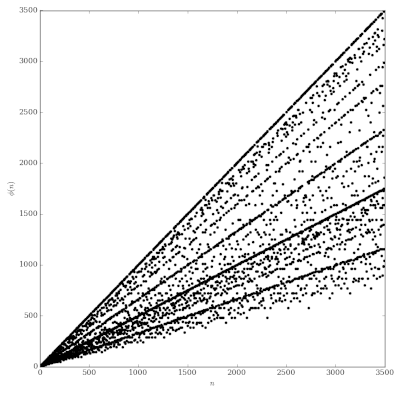Euler's Totient
Created:
2017-08-19
Updated:
2023-12-11
Given a natural number $n$, the Euler $\varphi$ function, also known as Euler’s Totient, applied to $n$ represents the number of positive numbers less than $n$ that are coprime with $n$.
Prime Power
$$ \varphi(p^n) = p^n (1 - \frac{1}{p}) $$Proposition. For a prime number $p$ and a natural number $n$:
Proof
Create a list of the numbers less than $p^n$ and count how many numbers in the list are not relatively prime to $p^n$.
Because $p$ is prime we are counting the multiples of $p$ that are less than $p^n$. There are $p^{n-1}$ such multiples, they are:
$$ \set{ 0, p, 2p, \ldots, p^{n-1} p } $$Thus, among the first $p^n$ numbers, $p^n - p^{n-1} = p^n (1 - 1/p)$ are coprime with $p^n$ ∎
Corollary. If $p$ is prime then $\varphi(p) = p - 1$.
Proof. Trivially follows the previous proposition for $n = 1$ ∎
Product of Primes
Proposition. For two primes $p$ and $q$,
$$ \varphi(pq) = \varphi(p) \varphi(q). $$
Proof
Given two primes $p$ and $q$, the elements $x < pq$ such that $\gcd(x, pq) \neq 1$ are:
- $A = \set{ 0 }$
- $B = \set { p, 2p, 3p, \dots, (q-1)p }$
- $C = \set { q, 2q, 3q, \dots, (p-1)q }$
The three sets are disjoint.
That is, if $ip = jq \implies q \mid (ip) \implies q \mid i$, and this is impossible because $i < q$.
Follows that:
$$ \varphi(pq) = |\mathbb{Z}_{pq}| - (|A| + |B| + |C|) = pq - (1 + (p-1) + (q-1)) = (p-1)(q-1) = \varphi(p)\varphi(q) $$∎
Product of Coprimes
Proposition. If $m$ and $n$ are coprime then $\varphi(mn) = \varphi(m)·\varphi(n)$
Proof Construct the table of numbers from $0$ to $mn - 1$ with $m$ rows and $n$ columns.
| 0 | 1 | 2 | … | j | … | (n-1) | |
|---|---|---|---|---|---|---|---|
| $0$ | $m+0$ | $m+1$ | $2m+0$ | … | $jm+0$ | … | $(n-1)m+0$ |
| $1$ | $m+1$ | $2m+1$ | $2m+1$ | … | $jm+1$ | … | $(n-1)m+1$ |
| … | … | … | … | … | … | … | … |
| $i$ | $m+i$ | $m+i$ | $2m+i$ | … | $jm+i$ | … | $(n-1)m+i$ |
| … | … | … | … | … | … | … | … |
| $m-1$ | $m+(m-1)$ | $m+(m-1)$ | $2m+(m-1)$ | … | $jm+(m-1)$ | … | $(n-1)m+(m-1)$ |
Proof (Alt). See CRT applications.
General Formula
The generic closed form formula for the sequence is:
φ(n) = n · ∏ (1 - 1/pᵢ)
With {pᵢ} the primes in the factorization of n.
Proof
From the above propositions and the fundamental theorem of arithmetic:
φ(n) = φ(∏ pᵢ^eᵢ) = ∏ φ(pᵢ^eᵢ) = ∏ pᵢ^eᵢ·(1 - 1/pᵢ) = n·∏(1 - 1/pᵢ)
Some values for the function
As can be easily seen from the table and the graph, the function is not monotonic.
| n | φ(n) |
|---|---|
| 1 | 1 |
| 2 | 1 |
| 3 | 2 |
| 4 | 2 |
| 5 | 4 |
| 6 | 2 |
| 7 | 6 |
| 8 | 4 |
| 9 | 6 |
| 10 | 4 |
| 11 | 10 |
| 12 | 4 |
| 13 | 12 |
| 14 | 6 |
| 15 | 8 |
| 16 | 8 |
| 17 | 16 |
| 18 | 6 |
| 19 | 18 |
| 20 | 8 |
| 21 | 12 |
| 22 | 10 |
| 23 | 22 |
| 24 | 8 |
| 25 | 20 |
| 26 | 12 |
| 27 | 18 |
| 28 | 12 |
| 29 | 28 |
| 30 | 8 |
| 31 | 30 |
| 32 | 16 |
| 33 | 20 |
| 34 | 16 |
| 35 | 24 |
| 36 | 12 |
| 37 | 36 |
| 38 | 18 |
| 39 | 24 |
| 40 | 16 |
| 41 | 40 |
| 42 | 12 |
| 43 | 42 |
| 44 | 20 |
| 45 | 24 |
| 46 | 22 |
| 47 | 46 |
| 48 | 16 |
| 49 | 42 |
| 50 | 20 |
| 51 | 32 |
| 52 | 24 |
| 53 | 52 |
| 54 | 18 |
| 55 | 40 |
| 56 | 24 |
| 57 | 36 |
| 58 | 28 |
| 59 | 58 |
| 60 | 16 |
| 61 | 60 |
| 62 | 30 |
| 63 | 36 |
| 64 | 32 |
| 65 | 48 |
| 66 | 20 |
| 67 | 66 |
| 68 | 32 |
| 69 | 44 |

References
- Modular Arithmetic Basics
- Chinese Remainder Theorem
- Sequence A000010 in the OEIS
- Wikipedia